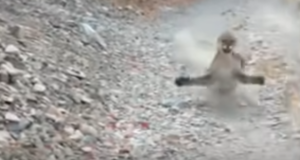Dutch Faro was jogging on a trail near California’s Pyramid Lake, filming the bluebird January scenery on his phone, when he spotted something coming out of the brush in his peripheral vision.
At first, he thought the large, dun animal was a dog wandering off-leash.
But when he turned to look, he saw a big pair of yellow, feline eyes staring at him.
“Didn’t take long to snap into reality it was a f—-n cougar,” Faro said in an email.
It’s not clear how often hikers encounter mountain lions. According to Justin Dellinger, a large carnivore researcher for the California Department of Fish and Wildlife, not all incidents are reported; in an email, Dellinger said he hadn’t heard about Faro’s experience until Backpacker contacted him.
The animal appeared to be a subadult, Dellinger said, a category that includes mountain lions up to about two years old. It was focused on Faro, whether as a potential meal or a threat to its cubs.
Its youth definitely worked in Faro’s favor, Dellinger adds, as it was “likely less experienced in hunting and procuring food.”
At first, Faro appeared to run even faster from the animal, but as it continued to approach, he changed tack. With only seconds to react, Faro says, he “resorted to [his] primal instincts.” He charged a few steps toward the animal and let out a roar. It worked: The lion turns around and scrambles back into the brush.
For the most part, cougars avoid interactions with humans. What caused the mountain lion to approach Faro is impossible to say for certain, but Dellinger says that the fact that Faro was running likely encouraged the animal to instinctively pursue him.
Scientists find “strange metal” that behaves in ways they don’t understand
When he noticed it, however, he made the right choice to stand his ground and make himself look “intimidating,” in this case by yelling and bluff charging.
However, other experts had different takes on Faro’s decision to step towards the lion: Travis Duncan, a public information supervisor for Colorado Parks and Wildlife, says that the agency doesn’t suggest people move toward or chase lions; instead, they “advise backing away slowly and making yourself look large.”
In Dellinger’s opinion, the incident is a good example of how hard it can be for hikers to be aware of their surroundings when they’re focused on taking video or pictures.
Regardless, cougars are common in California, he says, and the fact that more people don’t have run-ins like this is a testament to just how skilled the animals are “at making a living in and amongst people without anyone even knowing they’re there”—and just how uninterested they are in eating people.
Source: Backpacker
Ask me anything
Explore related questions





